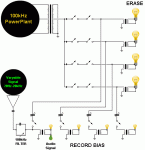Is there not just a "reference" votage that i can adjust the erase bias for??
Nop.

There's nothing to "adjust" in respect to erase head on those machines.
There's one single Bias "Power Station" for all and it serves erase heads 'directly' (through mechanical switch and through relay switch to be more specific, and it may be a good idea to check those, maybe dirty/oxy-rusty, you know).
I've made a simplified diagram (see attached pic).
You can adjust Record Bias for each Bias Switch Position by mean of vary-caps for each channel. In "the book" it is recommended to check/adjust Bias Traps first (not sure why). You can assume that yours are trapping just fine

Also the assumption is that you get to the point of BIAS adjustment after you went through Play Back / Heads / Record aligment (again, that is by the book). If you assume that there's no need or no issues anywhere there, or if you simply don't care, then you can try to tweak Record Bias.
You don't need MRL tape to adjust Record Bias level.
The procedure in general is: Use the fresh tape you want to use for recording, set the deck in record for the channel you are tweaking, set monitor switch to "TAPE" position , select the BIAS switch position 1 or 2 (depending on which one you going to adjust, the switch simply selects one of two adjustable capacitors).
You neet test tone Oscillator (source of steady signal, that is) to send to LINE input.
The frequency may vary (it depends), the level of the signal plus the input / output level knobs position need to give you "good reading" on the VU-meter.
In TEAC manual that I have it's 400Hz (-8dBm at input and at so-called speacified Input and Output level, which both are at knobs position pointing around "2 o'clock" or so).
So you start recording that signal and monitoring the VU-meter. Then you turn the Adjustable Cap to find the point where you get the highest reading on the meter - the Peak, and then from that point you turn the cap slightly more until the level drops a"bit".
How much to drop? That's a good question ...heh heh.
In the TEAC-book, they say - 0.5dB.
Different cook books, different meals - different stuff.
If you want to tweak by the book, you gotta get the book. And the book will tell you what else do you need to get so you can do it by the book

To get to the tweaking "Pod" - you need to remove bottom panel. I believe you will see sticker diagram on the inside of that panel showing different models and tweaking spots locations.
But, seriously, you better at least get the manual and read it one time

I am not sure if Rec Bias tweaking will fix your "problem" though. But I just can't know.
One thing you may want to try, though, before anything else.
Take fresh tape. Record all 4 channels something using THIS machine. Than erase and check if you still have exact the same "problem"
here's diagram:





 way .
way .

